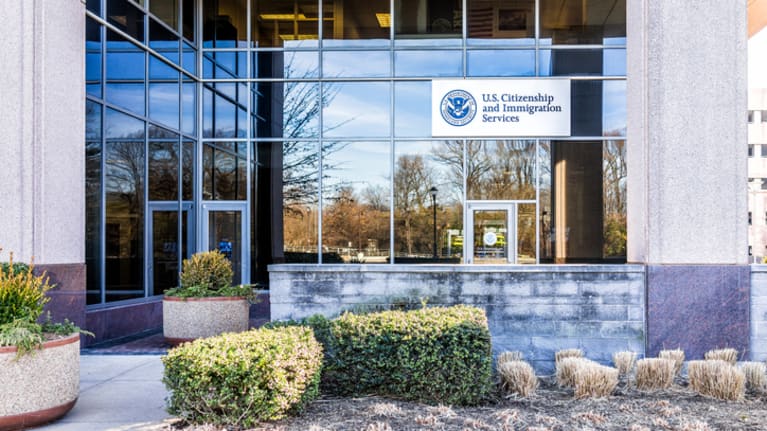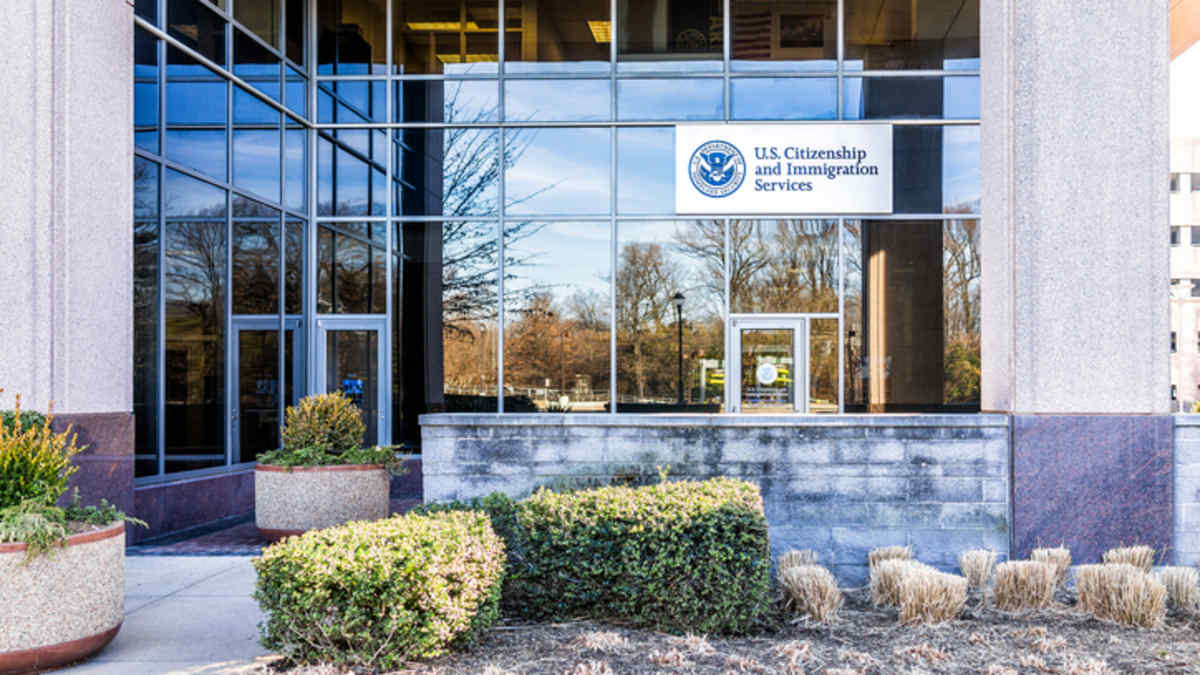

?U.S. Citizenship and Immigration Services (USCIS) Jan. 4 proposed a number of significant filing fee increases for multiple employment-based immigration petitions and applications, in part to help fund soaring asylum claims at the U.S.-Mexico border.
The agency in charge of administering the nation’s immigration system typically relies on user fees instead of congressional funding and stated that the new fees would allow it to “recover its operating costs, reestablish and maintain timely case processing, and prevent the accumulation of future case backlogs.”
The COVID-19 pandemic led to a dramatic reduction in immigration processing and revenue, depleted cash reserves, a temporary hiring freeze, and an increase in staff attrition. Immigration caseloads have since rebounded to pre-pandemic levels and asylum claims—where those seeking asylum pay nothing for processing petitions—have exploded.
USCIS last adjusted its fees in December 2016, with a weighted average increase of 21 percent. The latest proposal would represent a weighted average increase of 40 percent. The increased fees would allow USCIS to hire nearly 8,000 new employees to more quickly process new applications and address the growing backlogs, as well as fund upgraded information technology resources, the agency said.
The proposed changes would not take effect until after a 60-day public comment period is completed on March 6, the comments are evaluated, and a final rule is published and enacted, a process which can take several months.
“This new fee review and proposed rule is definitely an unwelcome proposal for employers, as the USCIS filing fees for many petitions will become more expensive,” said Andrew Wilson, a partner at Lippes Mathias Wexler Friedman and co-leader of the firm’s immigration practice in Buffalo, N.Y. “This could affect budget planning for immigration matters going forward. In addition to higher filing fees, it is an unwelcome proposal because I think it makes things unnecessarily confusing.”
Experts believe that the proposal could be a barrier to employers in need of foreign labor while failing to address the root inefficiencies in visa processing, which continue to worsen.
“We expect that there will be concerns from small businesses, nonprofits and educational institutions [that] are not generally in a position to absorb the enormous increase and will feel a disproportionate impact,” said Dawn Lurie, senior counsel in the Washington, D.C., office of Seyfarth.
She pointed out that the last time USCIS successfully increased fees, it took over seven months from the date the proposed rule was published before the new fees became effective. “It will take many months before the higher fees take effect, if at all,” she said, adding that “if the rule is finalized without significant changes, it is very likely that litigation will ensue.”
Form Filing Increases
Similar to a 2020 proposed rule from the Trump administration that was blocked in federal court and never implemented, USCIS is proposing different fees for different visa classifications. The current base fee of $460 covers all temporary-worker visa petitions using Form I-129—used by employers to petition for guest workers under H-1B, H-2A, H-2B, L-1, O-1 and TN visa classifications. The new filing fees would be:
- H-1B visas—$780
- L-1 visas—$1,385
- O-1 visas— $1,055
- TN visas—$1,015
- H-2A visas—up to $1,090
- H-2B visas—up to $1,080
“Under the proposed rule, employers hiring high-skilled foreign nationals will pay 70 percent more for beneficiaries on H-1B petitions, 201 percent more for employees on L-1 petitions and 129 percent more for individuals on O-1 petitions,” said Stuart Anderson, executive director of the National Foundation for American Policy, a public-policy research organization based in Arlington, Va.
“Fees for beneficiaries for H-2A petitions for agricultural workers will rise by 137 percent and for H-2B petitions for seasonal, nonagricultural workers by 135 percent,” he said.
Employers filing Form I-140 for employment-based green cards will see only a 2 percent filing fee increase from $700 to $715.
In addition to the filing fee increases, USCIS is also proposing a new $600 asylum program fee to be paid by all employers sponsoring temporary workers or workers for permanent residence visas. The fee would apply each time an employer used Form I-129 for an initial petition, change of status, or extension of stay. This additional fee is intended to be used to help fund the administration of the asylum program.
Experts said that this measure could face legal challenges from employers who feel they shouldn’t be on the hook for asylum-related costs. “With the $600 fee on petitions to fund the asylum program, the federal government is requiring employers to pay for something from which they receive no benefit,” Anderson said. “USCIS is likely to receive many comments about that.”
Notably, employers already pay additional fees to petition USCIS for H or L visa workers. For example, companies applying for H-1B workers pay a $500 fraud detection fee—separate from the actual application fee—in most cases.
USCIS is also proposing to add fees to cover biometrics services when they are required and to offer separate filing fees based on filing certain petitions online or by mail, even though there are only a limited number of forms available online.
New Fees for Adjustment-of-Status Applications
Another significant increase in fees would impact those seeking to adjust their status from temporary to permanent. Filing forms I-485 (adjustment of status), I-131 (for advance parole) and I-765 for a work permit (unless done electronically), with biometric services, would increase by 130 percent.
Currently, individuals pay a filing fee of $1,225, which covers the adjustment application as well as applications for employment authorization and travel documents and any future renewals for those documents while the adjustment case is pending. USCIS is proposing separate fees for the three forms, adding up to $2,820, not including each subsequent employment authorization and advance parole application, until the adjustment of status is adjudicated.
“I understand the increased costs of doing business, but these increases seem excessive,” Wilson said. “For example, for a family of four submitting I-485/765/131 filings as the final step of the green card process, the total filing fees could be $11,280. It’s beyond excessive; it almost feels punitive.”
H-1B Registration Fee Increase
The rule also proposes to significantly raise the fee to use the H-1B electronic registration system from $10 for each worker to $215, an increase of over 2,000 percent. The agency stated that the increase is the result of a review of the cost of administering the H-1B registration system, begun in 2020, and that fee increases were always intended.
“I do not think many employers will flinch at this increase, and this is also one area where USCIS has greatly improved its logistics and processing,” Wilson said.
Steven Brouillard, an attorney in the Boston office of Seyfarth, noted that the comment period makes it impossible for this increase to be implemented for the upcoming H-1B cap registration in March.
Premium Processing Change
Just like the 2020 proposed rule from the Trump administration, USCIS is seeking to extend the premium processing period from 15 calendar days to 15 business days.
“Business days are defined as the days that the federal government is open for business, which does not include weekends or federally observed holidays,” Brouillard said. “This could add a one-to-two-week delay to case processing.”
The $2,500 premium processing fee for most guest worker and green card petitions would not increase.
“You would therefore pay the same premium processing fee for a slower processing time,” Wilson said. “The proposed rule also shows that USCIS is unfortunately not close to implementing additional premium processing options under an already published rule. While that rule expands premium processing availability to include I-539s and I-765s, USCIS concedes that it is not close to making this available yet. USCIS estimates that full implementation of expanded premium processing is estimated to be complete around fiscal year 2025.”

